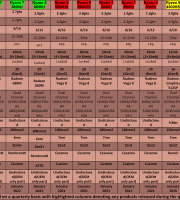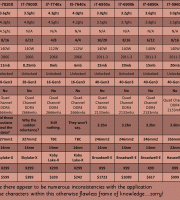


In May 2015 the adorably abominable baron von Intel shrewdly surveyed a billowing binary horizon scattered with ever more swift and spacious collators of digitally interpreted humanity. Cracking his sparkling silicon knuckles for 10 fleeting nanoseconds he decided the time had come to marry sublime solidarity to mollified volatility and boldly blitzed us with a brand new breed of exceptionally brisk repositories .
The technical roots of NVME (Non-volatile memory express), date back to 2009 and were the fruits of a consortium composed of over 90 companies. From 2010 to 2013, the design underwent three revisions and received its maiden commercial implementation in 2012, courtesy of Integrated Device Technologies.
Its primary purpose was to promote a definitive platform for data conveyance in an era when solid state devices stood poised to become the industries’ preference over their revolving ancestors and ultimately, to displace AHCI an ageing and progressively cumbersome interface which had been conceived with only the latter in mind.
Two years later, Soule Based electronics empire Samsung turned to the OEM market and gave benchmark famished reviewers the enviable opportunity to dither and eulogize over the benefits of this ground breaking medium, in the guise of its XS1715, an enterprise class product capable of read rates in excess of 3 Gigabytes per second, and write speeds approaching 1.4.
Mere months later, Intel resoundingly entered fray and, just as his initial venture into the world of “stationary” archiving had solidified new standards, so too did these polished, placid paraphrases transcend the powers f all their contemporaries.
His scintillating synergy of NvMe blessed benefactors totalled no less than eight incarnations. These were divided into four categories according to their I/O credentials, with two models per category, a half-height PCI-E card, and a standard 2.5” drive which in turn, were available in several capacities.
The P3500, P3600 and P3700 product lines were high-end business solutions, targeted at cutting edge data centres, professional content creators, rich companies seeking to justify inflaming budgets through sundry projects requiring boundless banks of servers, people who referred to their computer as a workstation, or insanely profligate enthusiasts who considered “professional” to be a redundant term in an age of self-financed fantasies.
By contrast, The 750 was a consumer engineered variant with a lower life expectancy but superior performance for the price.
The traditional NVME SSDs fostered a connector which was visibly indistinguishable to that observed on prototype SATA express products such as Asus’s Hyper Express, an enclosure designed to integrate two m.2 modules and a hybrid drive from Western Digital’s top of the range “Black” series that combined a 4tb mechanical disk and a 128GB SSD. The SFF-8639, hardly a memorable moniker, catered for faster throughput by using previously unallocated pins to exploit additional PCI express lanes, raising the total number from two to four.
In order to accommodate standard NVME drives, the host system required a MiniSAS or SFF-8643 port, until then, an almost exclusive feature of extravagant RAID controller cards and server grade motherboards. To resolve this, several forges of masterful peripheral hospitality hatched reworked BIOSES and a nifty adaptor to convert their board’s M.2 slots to MiniSAS sockets. Asus’s creation, entitled the “Hyper Kit, came bundled with its TUF Sabertooth X99 board and was available as an optional upgrade to owners of other Asus boards incorporating Intel’s Haswell-E chipset.
MSI were quick to follow with their M.2 to turbo MiniSAS converter, which, somewhat more generously, was enclosed with every one of the vendor’s x99 boards from June 2015 onwards and could also be purchased separately to install in any Hawell-E board equipped with an M.2 socket.
Officially, the slots needed to be wired to four third generation PCI-E lanes, though the latter requirement was only essential if one wanted to be certain of optimum transfer rates.
Assuming manufacturers had released BIOSes that contained the necessary modifications, there was no technical reason for these adaptors and their associated SSDs to refuse to function when used with any PCI-E M.2 slot regardless of type, or the number of lanes available.
For example, Gigabyte’s SOC Force x99 drew its NGFF sustenance from the chipset (PCH) in order to allocate all of the CPU’s bandwidth to the board’s PCI-E slots, thus, its M.2 socket, though 4 lanes wide, only supported second generation speeds and was hence capped to a maximum of 500 megabytes per lane and a total of 2.0 gigabytes per second. For two lane M.2 slots, the limit decreased 1000 megabytes per second.
With nascent NVMe drives showcasing typical read/write rates in excess of 3.0 and 1.4 gigabytes per second respectively, this was not sufficient to reap the full benefits of the protocol. Therefore, those without the choice a third tier NGFF socket, were better off opting for a card moulded drive and even then, there were further vexatious dilemmas to consider.
Boards constructed around Intel’s mainstream chipsets such as the Z-77, 87 and 97, were each assigned a quota of 16 3rd generation lanes over which to carry data to and from the PCI-E subsystem. If the user elected to install a high end video card in one of the slots, all 16 lanes could either serve it exclusively or be divided amongst additional peripherals in portions of 8 or 4. As the NVMe SSDs occupied 4 lanes, this negated the possibility of SLI, since Nvidia’s pixel preachers demanded a minimum of 8 lanes in order to render concurrently, though a Crossfire setup composed of two AMD cards feeding off 8 and 4 lanes, coupled with an SSD that exploited the remaining four, was a viable alternative.
For a mainstreamer whose motherboard harboured our magical multiplexor, the PLX chip, that effectively doubled the number of lanes through scrupulous PCI traffic management, this was not an issue. Regrettably, not all were wealthy or wily enough to account for their future desires.